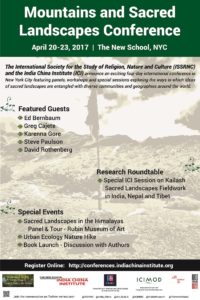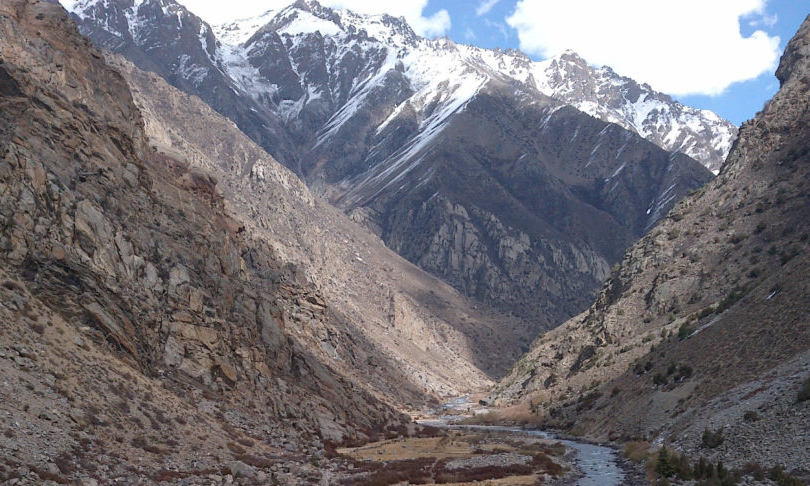The Sacred Himalaya Initiative, 2014-2017
The Sacred Himalaya Initiative: Sacred Landscapes and Sustainable Futures was built on the success of the Everyday Religion and Sustainable Environments in the Himalaya Initiative (2010-2013) and explored links between religious beliefs and environmental sustainability. ICI worked with a team of researchers from India, China, Nepal, and the United States to study and document relationships between religion and ecology focusing on sacred landscapes, pilgrimage routes, and ecological, economic and cultural sustainability and resilience in the Himalayas.
The Himalaya is one of the most diverse religious, cultural, and ecological regions in the world, and it continues to be the focus of important global scholarship. Rapid changes associated with increased tourism, environmental degradation, and climate change there have negatively impacted the livelihoods of local communities, however, and highlight the need to develop strategies for long-term ecological and economic sustainability. The rich socio-religious traditions of the region provide a framework for developing climate adaptation strategies.
The Sacred Himalaya Initiative was based on the Kailash Sacred Landscape region, and participants worked with local communities and the Nepal-based International Centre for Integrated Mountain Development (ICIMOD) on field research. The resulting program was the Kailash Sacred Landscape Conservation and Development Initiative (KSLCDI), made up of an expanded community of scholars which generated ethnographically-informed research on the intersections of religion and ecology in Himalayan communities.
A unique region:
The Kailash Sacred Landscape (KSL) is an ecologically and culturally diverse landscape spanning three countries: the remote southwestern portion of the Tibet Autonomous Region of China (TAR); adjacent districts in the Far Western Region of Nepal; and the northeastern flank of Uttarakhand State in northern India. The KSL’s unique geography is noted for high altitude lakes, mountain peaks, and permafrost. It is also significant for its size (11,969 square miles), and its ecological dynamics: the area forms the upper catchment for four of Asia’s major rivers: the Indus, Sutlej, Brahmaputra, and Karnali/Ganga. More than one million people live downstream from those rivers and their livelihoods depend on the continued environmental health of the waterways.
One of the most ecologically significant aspects of the KSL is its biodiversity, as there are wetlands, old growth forests, and rangelands that provide habitats for numerous species. In addition to the beauty and importance of the landscape, the cultural, religious, and historical importance makes much of the region sacred, and there are numerous pilgrimage routes and sites throughout the area. The KSL is deeply meaningful to five religious communities: Hindus, Buddhists, Jains, Sikhs, and Bönpos. One of the main goals of the Sacred Himalaya Initiative was to deepen knowledge and shape policy about how communities can address the interplay of ecology, religion and cultural factors to create sustainable futures for residents of this region.
What makes Kailash a sacred space?
The KSL is home to many individual sacred human-made as well as natural places (shrines, sacred rivers) as well as a vast network of pilgrimage routes intersecting the Himalaya, as mentioned above, that are meaningful to the many different religious groups. Mount Kailash and the adjacent Lake Manasarovar (both within the TAR, in China) are foremost among these sacred places sites.
Within India, the practice of tirthayatra, the act of making a spiritual journey to a sacred spot, has a long tradition going back to the Rig Veda and Mahabharata, and is considered a devotional sacred duty by Hindus.
For many Tibetan Buddhist and Bon pilgrims, the practice of ritually circling Mount Kailash, referred to as kora or kyang khor, plays a central role in the spiritual cleansing of pilgrims and acts as a way to connect with mountain spirits and generate merit, which is important for a person’s growth toward enlightenment.
For Jains, the top of Mount Kailash is said to be the site where Bhagavan Rishabha, the tirthankara or holy founder of Jainism, first achieved spiritual liberation, and the base is a pilgrimage destination.
Guru Nanak, the founder of Sikhism, is similarly said to have made an important pilgrimage to Mount Kailash, where he learned many great spiritual lessons that he recorded in the Sidh Gohst, or Dialogue with the Sages.
Lastly, in the indigenous Bön tradition its founder, Tonpa Shenrab, took up residence near Mount Kailash and established the ancient Zhang Zhung civilization.
Ethnographic Research
This initiative involved ethnographic field research in the KSL region. That work supported other research efforts seeking to understand and document everyday lived religion and the mapping of sacred values, meaning, and symbolism across a diverse and shared landscape. Field research was focused on several specific areas within the KSL, allowing for a richer and more nuanced set of case studies to be developed. Ethnographic field work was combined with literature reviews; strategic workshops with key scholars from India, China and Nepal; in-depth community interviews and oral histories; and community focus groups.
Everyday Religion
Like its predecessor, the Everyday Religion and Sustainable Environments, this project drew on a recent movement by scholars to see a holistic framework in research known as lived religion. This epistemological approach can be compared to what in past scholarship was thought to be the exclusive domain of religious specialists–in other words, that of prophets, priests, shamans, and monks. Exploring “lived religion” focuses on ordinary people as religious actors, and how they integrate their many concerns and the lives of their communities into a spiritual and religious practice and set of beliefs.
Another research component was to document the flows of cultures, goods, peoples, and ecosystem services within the KSL. This approach was aimed at policy development related to the question of religious resources in shared sacred landscapes. Improved regional case studies focused on sacred landscapes and religious resources and helped highlight relevant and overlooked community concerns, information and data that can inform and guide policymakers and scholars.
Mountains and Sacred Landscapes Conference
April 2017
Shared Sacred Landscapes: Stories from Mt. Kailas
Edited and retold by
Folk Gods – Stories from Kailash, Tise, and Kang Rimpoche
Retold by Prawin Adhikari
This initiative was supported by a generous grant from
The Luce Foundation.




